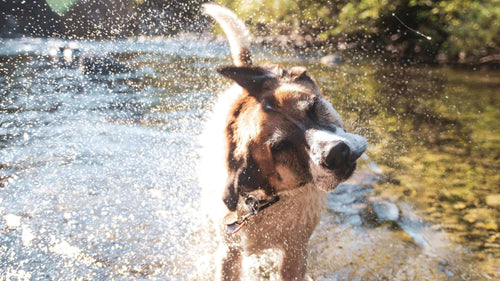
Redbarn's Traveling Guide for Dogs
Share
You’re preparing for a trip, packing your bags as carefully as possible. You’re making sure not to forget anything you may need, like those five different pairs of shoes for your three-day trip, your selfie stick, and your polaroid camera.
Check!
You’re all set to go when you suddenly feel a tug. You look down to see your faithful companion nudging at your leg, almost as if they were saying, “you can’t go without me!”
We’ve all been there.
The idea of a vacation or get-away with your dog sounds fun, but what if this is the first time you’re taking your dog away from home, long-distance, or on a plane? Even though most dogs love going outside, there are a few obstacles you may come across when you embark on that well-deserved vacation. The challenges of new environments, people, and stress brought on by travel make it essential to prepare accordingly before traveling with your pup.
If you’re traveling with dogs for the holidays or going on vacation, there are a few steps you can take to make for a smooth trip and a happy puppy (and pet parent)! Take a moment to use our guide below, and you just might find planning a trip with your dog(s) proves easier than you first thought!
Pet-Friendly Accommodations
Before em”bark”ing on any long or short distance trip with your dog, make sure all the places you’re going are pet-friendly. This includes venues, hotels, airlines, trains, and other modes of transportation. If going by car, it’s a great idea to be proactive and check for rest stops and veterinarians along your route in case of emergencies.
Avoid Feeding Before the Trip
On the day of travel, you may want to avoid feeding your dogs before leaving. If you feel snacks are not sufficient and worry your pup may be hungry, you can feed your dogs a smaller portion of their food at least three or four hours before getting on the road to avoid illness (and excessive potty breaks!).
Pre-trip Vet Visit
Be sure to have your dog(s) checked by your vet before your trip. If you’ve never taken your dog the vet before, now is a great time to start.
Be sure to also ask your veterinarian about possible motion sickness, especially if you’re taking a new mode of transportation for your pup. They may suggest over-the-counter drugs that should be given according to the recommended dosage or prescribe medications through their office, if deemed necessary.
Pack the Essentials!
Packing the right items for your dog’s trip is just as important as bringing all the vital essentials in your travel bag. Here’s what you’ll definitely need to add to your packing list:

Redbarn’s Dog Traveling Packing Guide
- A leash
- A collar or harness
- Pet or baby wipes
- Identification tags
- Dog carrier with a comfy bed or blanket
- Food and water dishes
- Bottles of clean water
- Dog food
- Dog treats
- Their favorite toy
- Potty pads
- Poop bags
- Medication
- Updated vaccination records
- Photo of your pet in case of loss or another emergency
Before You and Fido Hit the Road (or Sky!)
Exercise! Exercise your dog well before your departure to use up some of their energy and make them more comfortable during the trip.
Get Microchipped! Microchip implants for your pet can help calm concerns about losing your pet while away from home. Be sure your dog is properly microchipped if you choose to use one. Wearing a collar or harness with current identification tags is another way to keep track of your pet. The United States does not require that your pet be identified with a pet microchip, but it is recommended that you microchip your dog(s) and register your contact information prior to traveling as a means of identification should your pet be lost or separated from you.
Double Check Your Bags! Securely pack your bags with all your needs, except for your pup. Save the best for last!
Make Them Comfortable
Traveling by car? The good news is, most dogs love car rides! Although this may be true, anytime you’re placing your dog(s) in a new environment it becomes essential to keep them as comfortable as possible. When traveling by car, be sure to prepare your travel back using the list above. Once your dog is comfortable in their crate, you can gradually introduce them to the idea of a road trip.
Practice Makes Perfect
Older dogs may require a little more time and patience. Start with a trip around the block a couple of times until they are comfortable. Eventually, try taking your dog on longer and longer car rides. Some dogs may never totally enjoy the experience of a long car ride, but most will adjust with time, patience, and persistence.

4 Tips for Traveling with Your Dog by Car
Road trips are a great way to unwind and see new places. We get into our cars, turn on our favorite jams and drive off into a whole new world of adventure. If you’re planning on jumping behind the wheel and taking our pup on a road trip, here are a few tips to keep in mind:
- Invest in a dog carrier.
- Keep your pet out of the front seat.
- Bring enough pet food and fresh water for the entire trip.
- Keep the car well ventilated.
- DO NOT let your dog(s) ride in the back of an open truck.
- DO NOT leave your dog(s) unattended in the car.
- DO NOT let your dog(s) ride with their heads sticking out of the window.
- Be prepared in advance with some aids for motion sickness, as discussed with your veterinarian.
- Ensure ahead of time that your pet is healthy and up-to-date on all vaccinations.
Tell your doctor if your impending trip and let him know where you are going. He will be able to advise you regarding any prevalent diseases or dangers that may affect your pet at your final destination. Most airlines, shelters, and pet-friendly accommodations require a current medical certification to guarantee your dogs are healthy and safe.
Stopping Along the Way
Along the way, you may need to stop for bathroom or snack breaks. If traveling a long distance, it’s best to stop every couple of hours so that your dogs can have a small snack, you can check in with how they’re feeling, and they can use the restroom.
Carriers and Crates
Excited dogs tend to try to move from one side of the car to the other, dying to see what’s going on around them. One of the most common injuries for dogs is due to accidents inside vehicles. Keeping your dog(s) in a crate is the best way to keep them safe during travel. Even crates can be thrown from a car window in severe accidents. Some modern dog carriers can also be strapped down with a seatbelt or bungee cord to avoid moving during travel.
Pro-tip: Using a carrier when traveling with dogs is easier when you begin at an early age.
Before your trip, ensure your dog is comfortable in a carrier; as it is the safest method of travel for your pup, whether a road trip, air travel, or just a visit to the veterinarian. Invest in a crate with a sturdy metal door. Most airlines will require this, as well.

Making Carriers and Crates More Comfortable
When it comes to choosing the right crate or carrier for your dog, comfortability is key. When finding the right size crate, make sure they can stand up and turn around. You may have noticed this, but dogs love to snuggle with clothes of a particular family member or companion. You can take their favorite blanket and rub it on that special someone to transfer the scent. This reminder will comfort your dog in their crate.
Consider Calming Products
If you have a particularly antsy or anxious dog, you may need to consider calming or anxiety-reducing products. For example, you can sprinkle an essential oil, like the popular lavender, in your dog’s carrier or on their favorite blanket or toys to help soothe their anxiety.
Other calming products may include light sedatives recommended by your vet and pills like puppy melatonin.
Traveling by Plane with Your Dog
If you’re traveling with your dog by plane, it’s important to prioritize keeping them comfortable and safe. Many of the same rules for car and train travel apply to travel by plane, but of course, there are many differences, as well.
Pets can travel on a commercial airline one of 3 ways: in-cabin, checked baggage and manifest cargo.
Checked Baggage Cabin
Dogs traveling in the cabin must fly with an adult passenger with an airline compliant carrier stowed under the seat.
Checked Baggage Cargo
Dogs not permitted in the cabin can be transported as checked baggage in the cargo hold under the plane.
Manifest Cargo
Unaccompanied or very large dogs will travel as manifest cargo under the plane. The difference between check baggage cargo and manifest cargo is that you will likely need to make reservations with the cargo department of the airline you are using.
Service/Comfort Animals
Service and Emotional Support Dogs can travel in the cabin with a disabled passenger on many airlines.
Traveling overseas? Check the requirements to see if your dog(s) need a passport.

4 Tips for Traveling by Plane with your Dog
- Stay Warm: Dress your dog(s) appropriately for the weather. Be aware of the weather when traveling. The airline you’ve chosen may not be monitored for warm or cold temperatures.
- Notify the Crew: Ensure the entire flight crew is aware of the pet onboard so that staff may consider checking in on it in cargo during flight for its safety and well-being.
- Mark Your Carrier: Make sure your dogs sufficiently identifiable with collar tags, identification, and microchip if they have one. Your carrier should include information like you and your pet’s name, address, phone number, and destination. And go one step further than just attaching a luggage tag; physically mark the carrier itself with all of your contact info in permanent ink. This will come in handy if the tag gets detached and lost. It is always advisable to paste a photo of your pet on the carrier as well.
- Opt for Fewer Transfers: Choose a flight with the least amount of stops and transfers in order to ward off any undue stress to your canine.
Cargo-Air Travel
Many airlines do not allow specific breeds from traveling in cargo, and some do not offer cargo for pets whatsoever. On some airlines, however, it is simply unavoidable, especially if you have a larger dog.
If your dog must travel by cargo-air, be sure to check the weather. According to the American Kennel Club, “Federal regulations prohibit shipping live animals as excess baggage or cargo if an animal will be exposed to temperatures that are below 45 degrees Fahrenheit or above 85 degrees Fahrenheit for more than four hours during departure, arrival, or while making connections.”
Each airline has its own variations on regulation and services. Double-check that your crate meets their specific requirements. If not, the airline may not allow you to use it.
Other Methods of Travel with Your Dog
Cars and Rideshare: Many cabs and rideshares have dog-friendly options, but always be sure to double-check before jumping into any car service with your dog!
Busses and Trains: Buses and trains usually allow small dogs on a certain route, but make sure to call before you go!
Boats: Traveling by boat requires the same amount of research as traveling by plane, bus, or train. Make sure to check with rules and guidelines before you go.
Rental Vehicles: If you’re renting a car for your trip, make sure you review their pet policies with them prior to booking your reservation. . You may need to sign an agreement or pay an extra fee based on their pet policy.
What to Do if Your Dog Cannot Travel
As a responsible pet parent, it’s important to ask yourself if taking your pet along is what’s best for him or her or if it’s just what’s best for you. Sometimes, despite all the preparation in the world, traveling with your dog(s) may not be feasible. You may have to consider a pet sitter or kennel for them to stay at rather than forcing your fearful dog to go on a stressful trip. Ultimately, that should all depend on your dog, their stress level, age, and health. When it comes to extravagant trips, dogs do best staying at home with a pet sitter checking in on them daily.
As a responsible pet parent, you know your dog best, and that includes how much they can handle. If your dog can easily adapt to change and loves new environments, travel is likely a safe option for them.
If this isn’t the case, though, and home is where the heart is, your dog may prefer to stay in a safe and familiar environment. Either way, do what is in their best interest)!
Plan for Emergencies and Unexpected Illness
Pet parents have a responsibility to have a written emergency plan in case they need to send their pets back home or leave them behind. The written plan you make for your pet(s) should include:
- How to Care: Some dogs have special needs when it comes to grooming, bathroom breaks, and even bedtime. If your dog has any unique routines that should be followed, be sure to include detailed instructions on how to care for them.
- Who to Call: Numbers to your primary vet and emergency contacts (that’s you!).
- Where to Stay: Make sure to have the contact details of at least one trusted family member or friend that could potentially care for your dog, or at the very least be the second point of contact. Both at the destination as well as at home.
- How to Pay: This includes Financial instructions and medical resources your pet may need in an emergency. Be sure to leave details like phone numbers, hours of operation, names, and email addresses, as well.
Bottom Line:
- Do what’s best for your pet.
- Preparation is key! Pack your dog’s essentials and must-haves.
- Plan a pre-trip check-up with your veterinarian.
- Prepare up-to-date immunizations, certificates, and medications.
- Travel safe!
We hope this guide is beneficial to you next time you’re planning a trip or getaway with Fido!



